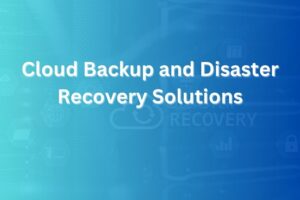

In today’s digital landscape, your organization simply cannot afford downtime or data loss. Cloud backup and disaster recovery solutions help you survive data corruption, cyberattacks, system failures, and even natural disasters.
In this article you will learn how cloud backup and disaster recovery work, why they matter, how to choose the right solution, and best practices to protect your business.
Cloud backup refers to the copy of your data, files, applications or system states stored in a remote cloud environment away from your primary location. Disaster recovery (DR) goes a step further: it includes the processes, tools and strategies to restore operations, not just recover data. While backup is about having data protected, disaster recovery is about using that data to resume business operations.
Traditional backup stored data on-site or in tape, but cloud backup shifts the storage to scalable, geographically diverse infrastructure. Disaster recovery in the cloud means failover to cloud servers, orchestrated recovery procedures, and minimal downtime.
You might think “we’re safe” because you have local backups or redundancy. But consider this: around 60% of small businesses that suffer a major data loss without a DR plan go out of business within six months. Cloud backup and DR solutions give you:
Cloud backup and DR offer a range of advantages:
When evaluating cloud backup and DR solutions, you must grasp the following concepts:
Recovery Point Objective (RPO): how much data loss you can tolerate, measured in time (seconds, minutes, hours).
Recovery Time Objective (RTO): how long your system can be down before causing severe business impact.
Failover / Failback: switching to a backup environment when primary fails (failover), then returning once the primary is safe (failback).
Replication & Backup Frequency: continuous replication offers minimal data loss; scheduled backups may result in more data gap.
Automation & Orchestration: the ability to run predefined scripts and workflows to bring systems back online automatically.
There are multiple strategies you can adopt, depending on your budget, risk appetite and technical constraints:
Selecting the right solution matters. Here are essential criteria:
Recent industry analysis shows that Disaster Recovery as a Service (DRaaS) adoption is surging, especially among small and medium businesses that lack in-house infrastructure for geographic failover. Cloud providers report that multi-region backup and recovery operations are accessed more often as ransomware incidents grow and regulatory pressure increases.
Even the best technology cannot save you if your process is flawed. Avoid these mistakes:
Here is a simplified roadmap you can follow to implement modern cloud backup and DR solutions:
Step 1: Define your objectives.
Document your RPO and RTO for each application, critical system and data set.
Step 2: Inventory your assets.
Map all workloads: virtual machines, containers, database systems, files, endpoints. Determine which are mission-critical.
Step 3: Choose the right model.
Decide whether backup-only, pilot light, warm standby or active-active is appropriate given budget and risk.
Step 4: Select a vendor or architecture.
Ensure the solution supports your cloud provider, on-premises workload, hybrid infrastructure, and provides automation and orchestration.
Step 5: Protect the data.
Implement backups to the cloud, enable immutability, encryption at rest and in transit, and ensure geographic diversity.
Step 6: Automate recovery procedures.
Use orchestration tools that can bring up services in the cloud with minimal manual steps. Regularly test failover.
Step 7: Monitor and review.
Track backup success rates, test recovery operations, review cost metrics, and refine the plan annually or after major changes.
Although cloud backup and DR bring major benefits, they also present challenges:
Cyber threats like ransomware escalate daily. If an attacker encrypts your on-premises storage and backups, you are effectively locked out. Cloud backup solutions offering immutable, off-site copies shield you from fast-moving threats.
On top of that, natural disasters like hurricanes, fires or regional outages can knock out local data centers or networks. Only a cloud-based backup and DR architecture, with geographic diversity and automation, ensures continuity when your primary site fails.
When reviewing providers, consider asking:
If you want your business to survive data loss, cyberattacks, hardware failures or natural disasters, investing in a robust cloud backup and disaster recovery solution is imperative. You want to sleep at night knowing your critical systems are protected, your data is backed up off-site, and you can recover quickly.
By defining your objectives, choosing the right architecture, selecting the right vendor and practising your DR procedures regularly, you transform backup from a cost centre into a competitive resilience advantage. In the ever-changing threat landscape of 2025, cloud backup and DR are no longer optional—they’re mandatory for business survival and continuity.
Showcase your skills, projects, and agency with Portlu—a modern, customizable HTML5 template designed for creative professionals.